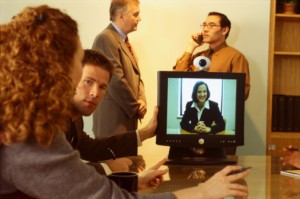The workplace is no longer just one place but many, with employees working virtually from home, on the road, and in multiple offices across the country and globe. According to Global Workplace Analytics, the number of telecommuters grew about 80% from 2005 to 2012. Clients are also scattered, as businesses target those that would most benefit their services, and they may not be just across town.
With employees, managers, and clients not always in the same place, there is potential for less effective communication and slower progress on collaborative projects between people who are not in the same office. Videoconferencing provides a communication channel that eliminates the need to drive to the office for a meeting while working at home or get caught up on a project after having been out of town meeting with a client. It is an invaluable part of modern work life that greatly improves corporate culture.
Table of Contents
More flexibility is allowed in the workday
 The availability of videoconference software for meeting attendance makes the rest of an employee’s work schedule more flexible throughout the day. Instead of having to schedule everything else around a meeting, employees and managers can be out doing what they need to do for their current projects and still make the afternoon meeting. For example, an architect can go out to a work site to go over building plans with a construction company, and later stop at the nearby Starbucks to follow up with his boss via videoconference, before going home to work remotely the rest of the day. Videoconferencing eliminates travel time to get back to the office and allows more important things to be scheduled.
The availability of videoconference software for meeting attendance makes the rest of an employee’s work schedule more flexible throughout the day. Instead of having to schedule everything else around a meeting, employees and managers can be out doing what they need to do for their current projects and still make the afternoon meeting. For example, an architect can go out to a work site to go over building plans with a construction company, and later stop at the nearby Starbucks to follow up with his boss via videoconference, before going home to work remotely the rest of the day. Videoconferencing eliminates travel time to get back to the office and allows more important things to be scheduled.
Work-life balance stays in check
For those who are fortunate enough to telecommute, video conferencing lets the phrase “work at home” be true 99 percent of the time. While some face-to-face meetings or other obligations may be required of some employees, most of the time their physical presence is not needed if they are working from home. Instead of being called into work to attend a meeting, or having to fly out of town for one pow-wow with a client, everything can be done using a computer with a webcam and mic. When employees are allowed to work at home, they often need to be there to watch kids or otherwise do “life stuff”– time commuting to and from work takes away from that. Employees just taking a day off don’t have to be told “no” due to a meeting, as they can virtually attend and then go about their vacation day as planned.
Productivity increases across the board
 Videoconferencing increases productivity primarily by improving communication. Virtual meetings where you can see the faces of all attendees are more engaging and less confusing the phone conferences, and allow important work documents to be shared easily with all interested parties. Virtual meetings can often be quicker and more time-efficient; they have a tendency to be short and to the point. There is a mutual understanding that everyone has somewhere else they need to be, so there is less time to “goof off” in the meeting. Meeting participants are also less likely to engage in side conversation. Everyone must be “on” for the duration of the meeting – like being on set for a TV production – and this makes participants come better prepared and with a mindset to meet goals and get things done.
Videoconferencing increases productivity primarily by improving communication. Virtual meetings where you can see the faces of all attendees are more engaging and less confusing the phone conferences, and allow important work documents to be shared easily with all interested parties. Virtual meetings can often be quicker and more time-efficient; they have a tendency to be short and to the point. There is a mutual understanding that everyone has somewhere else they need to be, so there is less time to “goof off” in the meeting. Meeting participants are also less likely to engage in side conversation. Everyone must be “on” for the duration of the meeting – like being on set for a TV production – and this makes participants come better prepared and with a mindset to meet goals and get things done.
Employees, clients and managers have greater work satisfaction
Employees benefit from videoconferencing because they have more time and freedom to do their work and are allowed the convenience to work from home or on the go as needed. Clients have easier access to the company employees they’re working with, and don’t have to travel or make travel arrangements for a company employee visit.
Managers and executives see greater cost-benefit rewards, both in saving their own time and the company’s money. The growth of global business has expanded many companies to across the country or overseas. Managers involved with projects and overseeing employees in other locations need to check in regularly with these offices. Instead of spending time and money flying out to a location, managers can simply arrange regular virtual meetings to go over plans and progress. This keeps both managers and executives happy – resources are conserved and results are seen in less time.
 By enabling easy, on-the-spot communication and collaboration, videoconferencing can overall improve the sense of satisfaction felt by clients, employees, and managers. This has to do both with the convenience of meeting virtually from any location and the increased productivity and flexibility it provides. Employees can do their jobs better and keep up with their personal/home life. Productive workers are more likely to stick with a job in which they feel satisfied, and managers and executives are more likely to want to keep them around – overall enhancing appreciation between employee and manager. A corporate culture that uses videoconferencing strategically can better serve the needs of the company at all levels.
By enabling easy, on-the-spot communication and collaboration, videoconferencing can overall improve the sense of satisfaction felt by clients, employees, and managers. This has to do both with the convenience of meeting virtually from any location and the increased productivity and flexibility it provides. Employees can do their jobs better and keep up with their personal/home life. Productive workers are more likely to stick with a job in which they feel satisfied, and managers and executives are more likely to want to keep them around – overall enhancing appreciation between employee and manager. A corporate culture that uses videoconferencing strategically can better serve the needs of the company at all levels.






